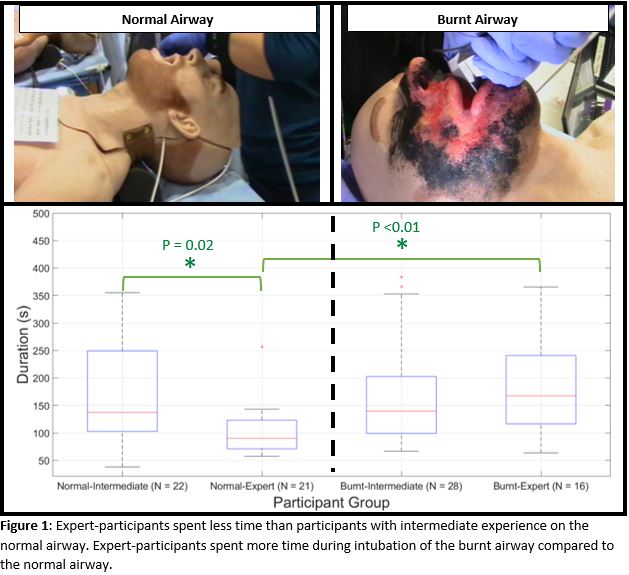PS9-07: ARE EXPERTS MORE CAUTIOUS? EFFECT OF SCENARIO VARIATION IN ADVANCED AIRWAY ASSESSMENT
Kenneth H Perrone, MD1, Hossein Mohamadipanah, PhD1, Su Yang, BS1, Anna Witt, BS1, Brett Wise, BS1, Cassidi Goll, BS1, Stefani Dawn, PhD2, Wade Eichhorn, BS2, Carla Pugh, MD, PhD1; 1Stanford, 27-Sigma
Introduction: Our prior work with a suturing task identified idle time as a significant marker of task difficulty and user experience. The work presented here sought to assess the difference in performance during simulated intubation tasks when comparing self-reported expert-participants and participants indicating intermediate experience. We hypothesized that expert-participants would outperform intermediate-participants during the intubation tasks and both groups would perform more slowly on the difficult intubation.
Methods: Participants (n=87) performed simulated intubations on a normal airway and a burnt airway in random order at the Anesthesiology Annual Meeting 2018 (Figure 1). The first intubation was used as a comparative control in this analysis to minimize bias from possible training effect. Participants completed a survey indicating their self-reported experience level. A Kruskal-Wallis test was performed to compare intubation times.
Results: Expert-participants intubated the normal airway more quickly than intermediate-participants (median 90±46 vs 137±101 sec p=0.02). However, there was no difference between the two groups on the burnt airway (median 167±87 vs 139±99 sec p=0.89). Expert-participants took less time to intubate the normal airway compared the burnt airway (median 90±46 vs 167±87 sec p<0.01). In contrast, intermediate-participants took a similar amount of time on both airways (median 137±101 vs 139±99 sec p=1.0) (Figure 1).
Conclusion: Expert-participants had longer intubation times on the burnt scenario than they did on the normal scenario. This may be due to a slower and more deliberate approach with increased idle time. Use of similar intubation times on both scenarios for intermediate-participants may indicate a lack of concern for airway edema in the burnt airway. Although expert-participants and intermediate-participants took similar times on the burnt airway, the expert-participants may have used their skills differently than intermediate-participants. These findings have significance for training and assessment of surgical residents and critical care fellows as they develop intubation skills. Future work using in depth video review will explore how the two groups used their time at each step during the procedure.

